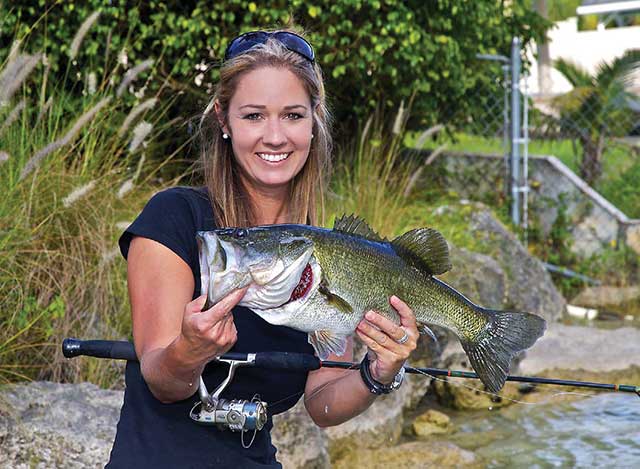Alligator Alley and Tamiami Trail
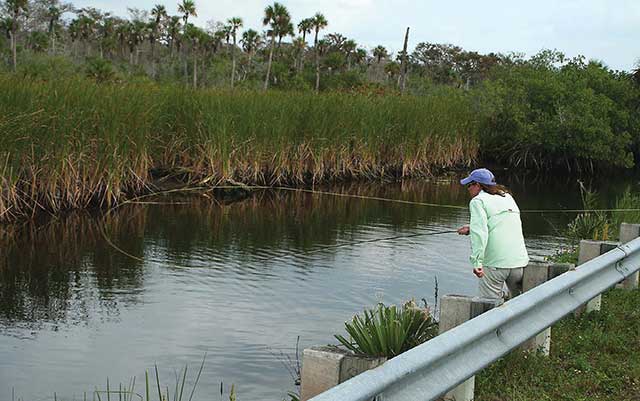
Diana Rudolph taps the Tamiami
Several major highways either traverse or border the Everglades, and they provide access for fishermen. I discuss all of them below. While the majority of anglers fish the swamps from a motorboat, you’ll find ample opportunity as a walk-in angler—especially if you bring a canoe.
Alligator Alley
Arguably the most popular highway with fishermen is the portion of Interstate 75 that connects Fort Lauderdale on the Atlantic Coast with Naples on the Gulf. Appropriately nicknamed “Alligator Alley,” this thoroughfare is an important conduit for gamefish as well as vehicles, and portions are bordered on both sides by canals. What makes the Alley so special? It’s the northernmost highway that crosses the Glades. Spring fishing, as you’ll recall, moves from north to south.

The exits that anglers fish most often are located within the first 30 miles heading west from the Lauderdale tollbooth. Unless you’re willing to pull over in 70mile-per-hour traffic, park in a ditch, crawl through a tangle of matted undergrowth, and climb a barbed wire fence, docks and ramps at the various launch sites are the best option, especially in spring when the fish are everywhere.
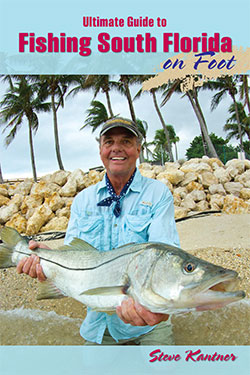
Buy the Ultimate Guide to Fishing South Florida on Foot in the MidCurrent store
I’ve caught plenty of fish from these floating structures, including hundreds of largemouths, peacocks, and even pickerel. Several seawall parking lots stretch for hundreds of yards, so an angler can cover both banks in solitude. An even better approach is to get your hands on a canoe or bass boat and work those banks you can’t reach from shore or from the ramps. As for a canoe, you’ll find plenty of fish within paddling distance, if they’re not already there at your feet. I don’t kayak in the Everglades, due to the danger of alligators.
Parking
When exploring these canals on my own, I never gave much thought as to whether it was legal to pull off the road and access these waters, but I recently researched the issue and found nothing definitive except for two interesting opinions, one from a higher-up with the Department of Transportation (DOT) and another from a police officer, both of whom wished to remain nameless. The DOT source said, “If you pull off the road, be sure it’s by at least two car-widths, and don’t attempt it if the area’s posted. If there’s metal siding, stay behind it.” The former state trooper said: “I wouldn’t leave a car parked alongside Florida’s Turnpike, where the state will tow it after 24 hours. The alley, however, may be a different story. If it was up to me, I’d simply let it slide.”
Broward County Tollbooth to Route 29, including Conservation Area 3 and parts of the Big Cypress Swamp
If you’re heading west across Alligator Alley, starting with the Broward County tollbooth (mile marker 26), you’ll find ramps on both sides of the road at (or near) mile markers 31 and 39, as well as at the first of two rest facilities, located near mile marker 36. Look for the mile markers—painted reflective green—along the road at one-mile intervals. The canals are bordered by dense vegetation, so I recommend launching a canoe at a well-maintained ramp or fishing from one of the boat launches.
Shore-bound anglers (or canoeists) can fish the Miami Canal, which passes under Alligator Alley near mile marker 36, after exiting the alley at the first rest (not recreation) facility. This ancient conduit connects Lake Okeechobee with L-67, the north-south canal that runs parallel to U.S. 27 in western Broward County. Follow the signs once you make the turnoff.
If you follow the underpass under the alley, you’ll find another ramp on the south alley canal—where the canal heads east.
If you turn around and continue heading west, you’ll cross several canals, including L-28, which passes underneath Alligator Alley near mile marker 49. L-28 is located on Miccosukee Tribe land and is off-limits to the general public.

The north alley canal continues west and is less deep in the Big Cypress Preserve. This shallower portion of the canal begins at the alley’s only gas station, located just off the highway at the Snake Road exit (mile marker 50). The station, which is owned by the Miccosukees, sells food and beverages. The restrooms are clean, and you’ll even find showers.
While access to this section is severely limited, the L-28 Interceptor Canal (which intersects the alley at mile marker 52 and shouldn’t be confused with the original L-28 that’s not open to the public) offers shore-bound anglers a few miles of access. Then, both north and south the canal enters tribe land, where trespassing is prohibited.
Both the Interceptor’s banks (they lie perpendicular to the alley) are reachable once you locate the turnoff, which is a pair of gravel roads that pass through a chain-link fence—not easy to see at 70 miles per hour. The gates, on either side of the road, are located above the easternmost bank—not far from the Alley bridge. Interested in crossing to the opposite bank? Take the buggy bridge a mile or two north and follow the gravel road.
A new launch ramp—complete with an exit—next to the alley bridge over the Interceptor, at mile marker 52 was under construction at the time of this writing. The ramp is on the west bank, immediately north of the bridge.
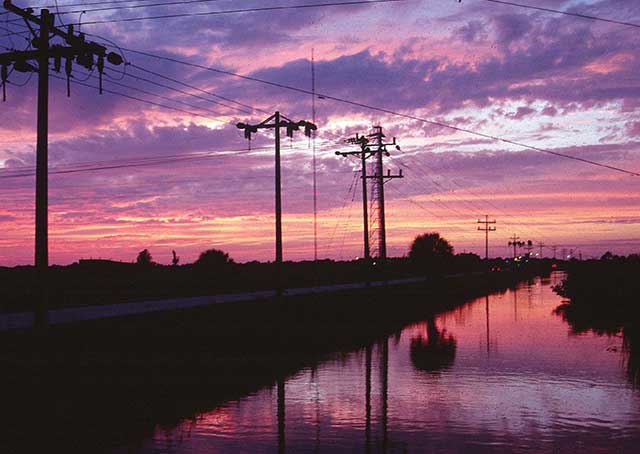
Winter sunset on the Tamiami Canal. This two-lane highway has served as an artery for commerce for nearly a century.
Tamiami Trail
Constructed during the late 1920s, with the intention of stimulating commerce between Tampa and Miami, the Tamiami Trail (U.S. 41) has remained a mecca for anglers—fly fishermen especially—since it first opened to traffic in 1928. It was the first road to cross the swamps.
The trail was popularized by outdoor writers who fished it during the 1950s and 60s. While the brackish portion of the Tamiami comes within a few miles of the Gulf, the first 100 miles west of Miami are freshwater habitat—similar in appearance to other Everglades canals. This part contains both bass and panfish.
Depending on water levels, fishing along the trail varies from somnolent to spectacular, with most of the action taking place during spring. In the summer, afternoon showers drown out the bite. It’s a fact of life in the Glades: High water puts a damper on fishing.
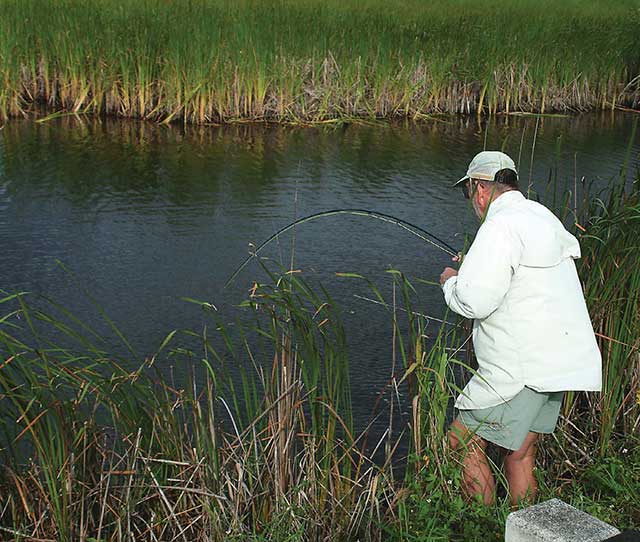
Fighting a snook in the Tamiami.
The trail is an extension of Miami’s SW Eighth Street, a road referred to by Miami’s Hispanic population as Calle Ocho. This heavily traveled street becomes a highway and crosses Interstate 95 and Florida’s turnpike before continuing west toward the Glades. Traffic on the trail is slower than on the alley, since this two-lane relic is popular with sightseers.
Unlike Alligator Alley, which parallels the Tamiami approximately 25 miles farther north, the Trail offers anglers ample bankside access. If you head west from Miami, you’ll notice several makeshift boat ramps. The one Marty Arostegui and I use is located 23 miles west of the Krome Avenue intersection, just this side of the microwave tower.
Several canals come in from the north—including L-67A, 10 miles west of the Krome Avenue Extension—and you’ll find a few levees that you can reach on foot. There’s a launch ramp on L-67A, just a few hundred yards from the trail. Plus, if you take the levee road even farther, you’ll find a second ramp on L-67C: a canal affectionately known as the “Magic Canal” because of the trophy bass it produces.
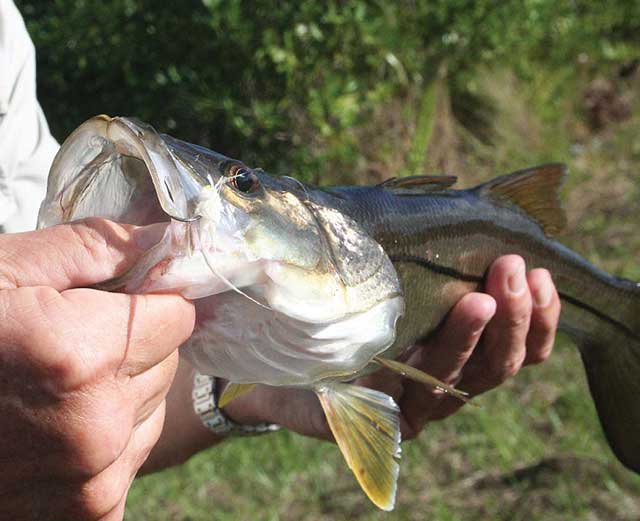
This snook hit a Squid Fly.
The farther west you travel on the trail, the more bridges you’ll see. While some span creeks that are essentially mud holes, others hold bass and bream. At the time of this writing, the federal government is raising up the Trail’s eastern portion in an effort to facilitate sheet flow: natural runoff headed for Florida Bay. The areas around bridges—like those near the Turner River campground, or Halfway Creek— harbor fish during late spring when the current is running.
You can usually find somewhere to park near these bridges, which, here in the interior, are typically short ones. Just be sure to pull off the road completely. Fishing from some spans is prohibited (there is no room for standing), so the best way to approach them is from either side, by casting beneath them or along the shorelines. A sign will be posted if fishing’s prohibited; if not, you’ll probably find a sidewalk.
The trail’s crowning glory begins with the salt marsh. Whether a largemouth bass or a 30-pound tarpon, predators rely on the shadows cast by bridges, from which they attack baitfish or grass shrimp. Individual tarpon prowl while snook and bass typically suspend in schools.
My strategy for casting under these bridges while remaining dry—though I wouldn’t recommend it to those who are afraid of breaking their fly rod—is to stand on the abutments that frame these bridges and launch a backhanded water haul. Aim well into the shadows, at least 20 feet back.
Wading for Trophy BassTrophy largemouth require a careful approach and proper presentation. Most trophies are spawners: females in prime condition. Here in South Florida, largemouths spawn from the full moon in November until the end of April. Waders shouldn’t have any trouble spotting the beds, which are usually protected by emergent vegetation. You’ll find them in 11⁄2 to 3 feet of water. Look for depressions on the bottom the size of saucers. Bedding bass, however, prefer calm lagoons surrounded by grass atolls. Most spawner fishing is a matter of sight-casting with weighted plastics. However, bedding fish in the Everglades also strike on top, a proclivity that attracts a small cadre of fly fishers.
Approach bedding fish with caution, while determining if the lady of the house is home. Spawners, for the most part, are easy to spot when they hover close to the nest. That, however, isn’t always the case, so make sure that no fish are guarding the bed before moving on. I’ll toss something squirmy to bedding fish and then allow it to settle while I gauge their reaction. If two fish are present, which they frequently are, I’ll catch and release the smaller, more aggressive male before working on the female. Spawners don’t behave like feeding fish. They’ll pick up a lure just to carry it off the bed but pay it no mind at all if they’re actively spawning. While a subtle twitch may trigger a strike, the odds are in your favor if you simply let it lie. Short plastic worms and crayfish imitations are ideal for this work. Bedding bass respond to flies, especially those patterns that mimic a threat—for example, a prowling water snake. Keep in mind when you’re dealing with bedding fish that they typically hang out in heavy cover—often inside a rim of grass—which makes it difficult to present a lure with freshwater fly gear. A 9- or 10-weight makes the job less daunting, since the heavier line pulls the fly to the surface. It’s also easier to cast the gargantuan flies that big bass prefer. A heavier rod is infinitely better for handling 15- or 20-pound tippets, which you’ll need to extract fish from weedy labyrinths. Another technique that’s effective for spawners, or fish that have recently spawned, is to reel a 10-inch worm along the shoreline. While you’ll see very few shorelines in the marsh, I remember this trick when I come across one, especially in winter when the bass are spawning. It’s also effective in canals. Here’s why: In canals, bass spawn over shallow gravel patches that form when the banks cave in. Since beds in these areas are difficult to spot, especially late in the day when spawners are active, you’ll need to cover lots of water. And that’s where reeling big worms comes in. You’ll deal with mats of vegetation punctuated here and there by openings. Say you’re casting a weighted plastic—keep reeling it across the mats and dropping it into the holes. While you allow it sink, you need only twitch it (just like when you’re flippin’), while staying alert for the slightest movement. Don’t be surprised if a bass explodes before you reach the hole. Drop your tip before rearing back the second your line comes tight. For this type of fishing, I prefer plug-casting gear, along with a heavy, non-stretch line—say, 30-pound PowerPro. Bass that are not spawning move around more than most anglers realize. These movements are dictated by a variety of factors, including water level, time of year, and ambient light. It’s not unusual if an area that previously held fish becomes suddenly devoid of them because the bass have moved to different cover—where you couldn’t buy a strike before. |
Excerpted from the Ultimate Guide to Fishing South Florida on Foot (Headwater Books, reprinted with permission).
